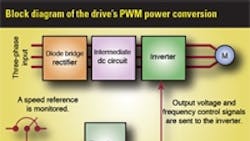Variable frequency drives
Adjustable speed drives (ASDs) or variable speed drives (VSDs), also called variable frequency drives (VFDs), typically control a motor's velocity or torque output.
Most adjustable frequency drives today use pulse width modulation or PWM to create a variable output voltage, current, and frequency. Here, a diode bridge rectifier takes alternating current (ac) power from a power source and provides an intermediate direct current (dc) circuit voltage. In the intermediate dc circuit, the dc voltage travels through a low-pass filter. Then, six high-speed electronic switches in the drive's inverter are controlled to create short pulses with the height of the dc bus voltage and of various widths.
By varying the pulse width, adjustable frequency drives create an output waveform with an average that is a sinusoidal voltage and current waveform for which frequency can be varied. It is this variable output that is used to control motor speed, torque, or position.
PWM is used in modern adjustable frequency drives because it is efficient. The output switches are either on or off, and don't operate in any intermediate states that can increase power dissipation and energy losses.
Motors driven by VFDs are sometimes fitted with position feedback devices. In these situations, feedback devices improve motor accuracy, dynamic response, and torque production at low speeds.
Q&A
How do variable frequency drives differ from servodrives?
Variable frequency drives typically control velocity or torque. In contrast, servodrives are often used to control motor position — and almost always use a position feedback device on the motor.
That said, recent drive technology advances are increasingly tailored to specific applications — and don't require changes to entire control systems when added. In addition, the traditional assumptions that VFDs and induction motors only control speed and servodrives and permanent magnet (PM) motors only control position are being challenged. Why?
First, there's more demand for higher motor efficiency in some VFD applications — so VFDs increasingly control PM motors. Second, the better performance of newer VFDs is rivaling that of servodrives. Finally. the emergence of Ethernet-based networks improves all types of control, including motion and drive control.
VFDs and servodrives share some characteristics: A motor connected to either kind of drive converts electrical energy supplied by the drive into rotary or linear motion. The motor output can be attached to any number of actuators or mechanical machines to do work.
Machines in assembly, web handling, converting, and packaging industries use both drive types to coordinate working axes and ultimately transform materials into everyday products.
How do VFDs communicate with other components?
Most modern drives are connected with other components in the control system using communication networks, allowing for improved diagnostics and machine control.
In addition, most drive suppliers today are moving from proprietary networks toward open networks for servodrives and VFDs. For example, EtherNet/IP can connect all of a plant's equipment, processes, and information (with one network architecture) to provide realtime information and control.
In fact, Ethernet-based networks allow more information than ever to flow from drives and other intelligent machine components into machine controls and eventually into plant-level control systems. Better integration between servodrives, VFDs, and controls also makes configuration and diagnostics easier.
How do newer VFDs differ from designs of the past?
Machines that are modular (with distributed controls) are increasingly common because they make designs more reliable and reusable.
Here, VFDs (as well as servodrives) are mounted directly onto machines. Moving control hardware closer to the application or onto the machine minimizes a design's physical footprint, simplifies connectivity, and reduces wiring and setup costs by up to 30%.
One caveat: Installing drives at the working parts of a machine exposes them to more abuse. To address this issue, many newer VFDs include better environmental resistance and ratings — for hot, cold, dusty, damp, sterile, and washdown environments.
This month's handy tips provided by Douglas B. Weber, business development manager of alternative energy and low voltage drives, Rockwell Automation, Milwaukee.
